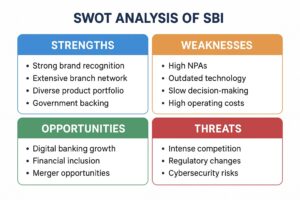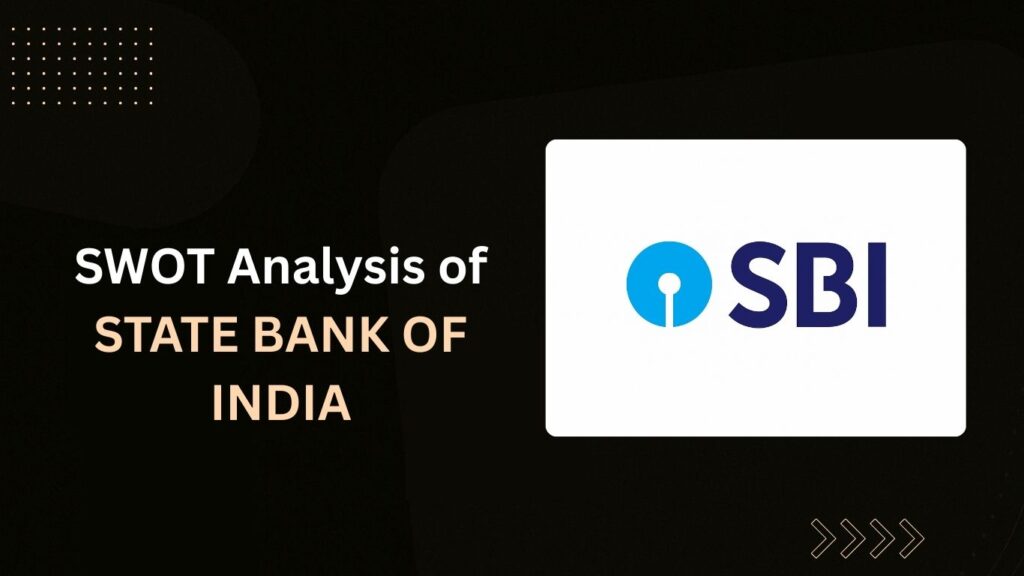
The State Bank of India (SBI) stands as the largest public sector bank in India, with a rich legacy spanning over two centuries. Founded as the Bank of Calcutta in 1806, it evolved into the Imperial Bank of India before becoming SBI in 1955 after nationalization. Today, it is a pillar of India’s financial landscape, serving millions of customers worldwide with a vast network of over 22,000 branches and 62,000 ATMs across India. With a presence in 36 countries, SBI has established itself as a significant global financial player, supporting India’s economic growth and stability.
Brief Overview of State Bank of India (SBI)
SBI’s journey from a regional bank to a global banking giant reflects its resilience and adaptability. It is renowned for offering a wide range of banking and financial services, including retail banking, corporate finance, wealth management, and digital solutions. Its technological advancements have set new benchmarks in the banking sector, making it a leader in digital transformation.
- Example: SBI’s YONO (You Only Need One) platform has revolutionized digital banking in India, integrating banking, shopping, and investment services into a single app, with over 60 million registered users and 10 million daily logins.
- Example: SBI’s “Green Remit Card” facilitates hassle-free cash deposits into accounts, promoting financial inclusion in rural areas.
Importance and Scale in the Indian Banking Sector
SBI plays a critical role in India’s financial ecosystem, acting as the backbone of the nation’s economy. It holds a significant share in both deposits and advances, making it a lifeline for businesses, individuals, and the government. With assets exceeding INR 57 lakh crore, SBI ranks among the top 50 banks globally by assets, underlining its financial strength and stability.
- Example: SBI’s Home Loan portfolio is the largest in India, supporting the government’s ‘Housing for All’ mission.
- Example: SBI’s Pradhan Mantri Jan Dhan Yojana (PMJDY) accounts make up a substantial portion of the total accounts opened under this financial inclusion scheme, reinforcing its commitment to economic empowerment.
- Example: SBI is a preferred banker for large infrastructure projects, including the Mumbai Metro and the Delhi-Mumbai Industrial Corridor, reflecting its critical role in national development.
SBI Bank at a Glance
| Founded | 1806 (Bank of Calcutta), 1955 (SBI) |
| Headquarters | Mumbai, India |
| Branches | 22,000+ |
| ATMs | 62,000+ |
| Employees | 250,000+ |
| Total Assets | INR 57 lakh crore+ |
| Annual Revenue (as of FY24) | US$53 billion |
| Net Income (as of FY24) | US$8.3 billion |
| Total Equity (as of FY24) | US$51 billion |
| Type of Bank | Public |
| Key People | Shri Dinesh Kumar Khara
Shri Rajesh Kumar Dubey CA Dharmendra Singh Shekhawat CA Prafulla P Chhajed Director Smt Swati Gupta. |
| Products Offered |
|
SBI Bank SWOT Analysis
Strengths of SBI Bank:
Market Leadership and Extensive Branch Network:
SBI holds a dominant position in the Indian banking market, with over 22% market share in deposits and advances. It has an extensive network of over 22,000 branches and 62,000 ATMs across India, reaching even the most remote areas. This vast physical presence, coupled with robust digital platforms, gives SBI a significant competitive advantage.
For instance, its branches in the Andaman and Nicobar Islands and the remote parts of Ladakh demonstrate its commitment to financial inclusion.
Strong Brand Reputation and Customer Trust:
With a history of over 200 years, SBI is one of the most trusted banking brands in India. Its strong government backing and reputation for stability reassure customers about the safety of their deposits.
For example, during the COVID-19 pandemic, SBI remained a stable financial institution while several smaller banks struggled with liquidity issues, further reinforcing customer trust.
Digital Banking Capabilities (YONO, Internet Banking):
SBI has been a leader in digital transformation with its flagship platform YONO (You Only Need One), which offers a comprehensive suite of banking, shopping, insurance, and investment services. With over 60 million registered users, YONO has set a benchmark for digital banking in India.
For example, YONO has been widely adopted by students and young professionals for its ease of use, offering features like instant personal loans, paperless account opening, and lifestyle benefits.
Financial Stability and Government Backing:
As a government-owned entity, SBI enjoys financial stability and credibility, allowing it to access funds at lower costs and withstand economic shocks.
For instance, during the 2008 global financial crisis, SBI’s strong backing helped it maintain liquidity while many private banks faced significant financial stress.
Weaknesses of SBI Bank:
High Non-Performing Assets (NPAs):
SBI has faced challenges with high NPAs, a common issue among public sector banks. This affects profitability and shareholder value.
For example, in 2018, SBI’s gross NPA ratio peaked at around 10.91%, leading to significant write-offs and provisioning.
Complex Organizational Structure:
Being one of the largest banks globally, SBI has a complex organizational structure, leading to bureaucratic delays and slower decision-making.
For instance, its large workforce of over 250,000 employees often results in higher operational costs and slower customer service response times.
Dependence on Domestic Market:
Despite a global footprint, SBI still relies heavily on the Indian market for a majority of its revenue, making it vulnerable to domestic economic fluctuations.
For example, during the 2016 demonetization drive in India, SBI’s operations were significantly impacted as it had to handle a massive influx of cash transactions.
Operational Challenges Due to Scale:
Managing a vast network of branches and employees can be a logistical challenge, resulting in higher operational costs.
For instance, maintaining ATMs and rural branches often incurs higher costs, impacting profitability.
Opportunities for SBI Bank:
Expansion in Rural and Semi-Urban Areas:
With over 65% of India’s population living in rural areas, SBI has significant opportunities to expand its reach.
For example, SBI has launched several financial literacy programs and rural banking initiatives to tap into this market, such as the ‘SBI Tiny’ account for rural banking.
Digital Transformation and Fintech Collaboration:
The rapid growth of fintech and digital payments presents an opportunity for SBI to innovate further.
For example, SBI has partnered with Paytm and other fintech firms to enhance digital payment capabilities and improve customer experience.
Growth in Retail and Corporate Banking:
Rising incomes and economic growth in India have increased demand for retail and corporate banking services.
For instance, SBI has aggressively marketed its home loans and SME financing products to capture a larger share of this growing market.
International Market Expansion:
SBI can leverage India’s growing influence globally to expand its international presence.
For example, SBI has over 200 branches in 32 countries, including major financial hubs like London, New York, and Dubai.
Threats to SBI Bank:
Intense Competition from Private and Foreign Banks:
Despite its market leadership, SBI faces intense competition from private sector banks like HDFC, ICICI, and Axis Bank.
For instance, these banks have been quicker in adopting digital banking solutions, attracting tech-savvy customers.
Regulatory Changes and Economic Instability:
Frequent regulatory changes can impact profitability.
For example, changes in RBI’s asset provisioning norms have sometimes forced SBI to set aside significant capital for bad loans.
Cybersecurity Risks in Digital Banking:
As SBI continues to expand its digital footprint, it becomes more vulnerable to cyber threats.
For example, in 2019, SBI faced a major security issue when its server exposed sensitive account information, highlighting the risks of digital banking.
Impact of Global Financial Crises:
Being a globally active bank, SBI is exposed to international financial risks.
For instance, the 2008 global financial crisis impacted its overseas operations and profitability, leading to tighter risk management policies.
Top Competitors of SBI Bank in India
HDFC Bank
Private Sector Leader: Known for its strong digital presence and customer service.
Retail and Corporate Banking: Focuses on both retail customers and corporate clients, providing a wide range of financial products.
Example: HDFC Bank’s ‘SmartHub Vyapar’ for merchants integrates payment solutions and business management tools, providing a seamless experience for small businesses.
ICICI Bank
Tech-Driven Approach: Pioneers in digital banking and innovative financial solutions.
Strong Corporate Banking: Known for its robust corporate and retail banking network.
Example: ICICI Bank’s ‘iMobile Pay’ offers free fund transfers, bill payments, and QR code-based payments to both customers and non-customers.
Punjab National Bank (PNB)
Public Sector Giant: Second-largest public sector bank in India.
Extensive Rural Network: Strong presence in rural areas, providing financial inclusion.
Example: PNB’s ‘PNB One’ mobile app provides end-to-end digital banking, including loan applications and investment services.
Axis Bank
Fast-Growing Private Bank: Known for personalized banking solutions.
Innovative Digital Banking: Invests heavily in fintech partnerships.
Example: Axis Bank’s ‘Burgundy Private’ is a premium banking service targeting HNIs with personalized wealth management solutions.
Bank of Baroda (BoB)
Global Presence: One of India’s largest public sector banks with a significant international footprint.
SME and Retail Focus: Known for SME support and extensive rural outreach.
Example: Bank of Baroda’s ‘Baroda Digital Lending’ platform offers instant digital loans to MSMEs.
Kotak Mahindra Bank
Innovative Financial Products: Known for its competitive interest rates and digital-first approach.
Example: Kotak’s ‘811 Digital Savings Account’ provides a completely digital account opening process without any minimum balance requirement.
Yes Bank
Agile and Customer-Centric: Focuses on customer experience and digital innovation.
Example: Yes Bank’s ‘Yes Robot’ AI chatbot provides personalized banking assistance 24/7.
IDFC FIRST Bank
Customer-Centric Approach: Known for high savings interest rates and innovative digital solutions.
Example: IDFC FIRST Bank’s ‘MyFIRST Partner App’ empowers customers to become business partners and earn through referrals.
Federal Bank
Strong NRI Base: Popular among non-resident Indians for its NRI banking services.
Example: Federal Bank’s ‘FedBook’ is a mobile passbook app that allows customers to view their transactions anytime.
IndusInd Bank
Personalized Banking: Known for its personalized financial solutions and digital-first approach.
Example: IndusInd Bank’s ‘Video KYC’ allows instant account opening through a video call, enhancing customer convenience.
Conclusion:
State Bank of India (SBI) continues to hold a dominant position in the Indian banking sector, backed by its unparalleled scale, extensive branch network, and deep customer trust. Nevertheless, in an environment marked by increasing competition and rapid technological advancements, SBI must persistently focus on innovation, strengthen its digital capabilities, and effectively manage and reduce Non-Performing Assets (NPAs). By doing so, it can sustain its leadership and meet the evolving needs of customers. With its solid foundation and a clear strategic vision, SBI is well-equipped to navigate future challenges and capitalize on emerging opportunities, ensuring sustained growth and success in the years to come.
FAQs
What is SBI’s market share in India?
SBI holds the largest market share among Indian banks, commanding around 22-23% of the total loan and deposit market. For example, as of the latest data, SBI’s total assets stand at over INR 55 trillion, making it a dominant player in the Indian banking sector.
How does SBI differ from private banks like HDFC and ICICI?
Unlike private banks like HDFC Bank and ICICI Bank, which focus heavily on retail and digital services, SBI has a broader mandate, including rural and financial inclusion services. For instance, HDFC’s market approach emphasizes digital innovations like PayZapp, while SBI’s YONO platform integrates banking, lifestyle, and shopping in a single app, reflecting its comprehensive reach.
What is YONO, and how is it transforming banking?
YONO (You Only Need One) is SBI’s integrated digital banking platform, offering banking, lifestyle, and investment services. With over 70 million downloads, YONO has revolutionized convenience banking by providing services like instant loans, insurance, and e-commerce within a single app.
How does SBI manage its non-performing assets?
SBI focuses on proactive recovery, strict risk assessment, and digital tracking to manage its non-performing assets (NPAs). For example, the bank launched Project Saksham to streamline recovery processes, reducing its gross NPA ratio to under 3.5% in recent years.
Why is SBI considered a safe bank?
SBI is backed by the Government of India, offering a secure deposit environment with a diversified portfolio and strong capital base. For instance, during financial crises like COVID-19, SBI’s robust balance sheet and government support ensured financial stability for its customers.
How has SBI responded to digital banking trends?
SBI has rapidly expanded its digital footprint with platforms like YONO, INB (Internet Banking), and UPI services. For example, YONO contributed significantly to SBI’s digital transaction volume crossing INR 10 trillion in recent years, reinforcing its digital dominance.
What are SBI’s international operations?
SBI has a global presence with over 200 offices in 30+ countries, serving both Indian diaspora and local businesses. For instance, SBI UK provides retail and corporate banking services, while SBI Singapore is known for trade finance and wealth management.
What challenges does SBI face in the digital era?
SBI faces challenges like intense competition from fintech, cybersecurity risks, and the need for continuous digital innovation. For example, ICICI’s iMobile and HDFC’s SmartHub have set high standards for digital banking, pushing SBI to innovate constantly.
How does SBI support financial inclusion?
SBI plays a pivotal role in financial inclusion through Jan Dhan accounts, microfinance, and rural banking. For example, it has opened over 48 crore Pradhan Mantri Jan Dhan Yojana (PMJDY) accounts, promoting financial inclusion across India.
What is the future outlook for SBI?
SBI aims to enhance digital transformation, expand its global footprint, and strengthen its retail and SME lending. For instance, its focus on AI-driven services like YONO 2.0 and blockchain technology positions it for sustained growth in the evolving financial landscape.
A passionate blogger and digital marketer, specializing in creating engaging content and implementing result-driven marketing strategies. She is dedicated to helping brands grow their online presence and connect with their audience effectively.

